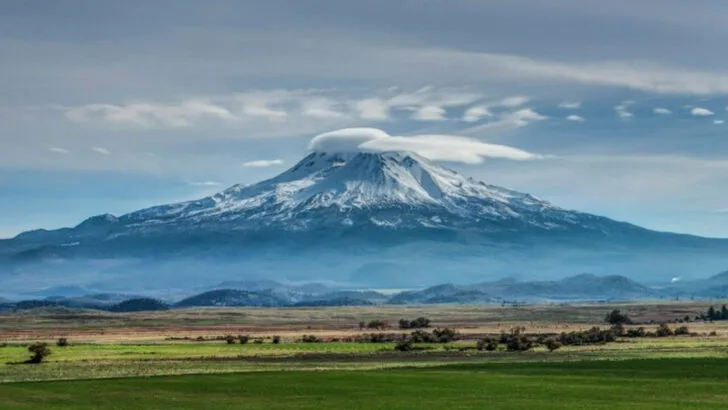The ground beneath your feet isn’t as quiet as it seems. All across the U.S., ancient giants lie sleeping— massive volcanic sites tucked behind hiking trails, under forests, and in the middle of lakes that shouldn’t even exist. Some look like peaceful meadows. Some hiss, bubble, and steam like they’re telling you to keep walking. But all of them carry stories of eruptions so big they once changed the sky. These aren’t museum relics. They’re alive. And if you know where to look, you can walk straight into their craters. Ready to feel small in the best way possible? These 14 hidden volcanic wonders are waiting.
Yellowstone Caldera, Wyoming
Yellowstone Caldera is a volcanic marvel located in the heart of Wyoming. Known for its geothermal features like geysers and hot springs, this site offers a unique glimpse into the earth’s inner workings. The caldera, formed by a massive volcanic eruption, spans 30 miles and is a testament to nature’s power.
Visitors are often captivated by the vibrant colors of the hot springs and the unpredictable eruptions of geysers like Old Faithful. Despite its serene appearance, the caldera is a reminder of the volatile forces lying beneath.
A visit here is both a scenic and educational experience.
Crater Lake, Oregon
Crater Lake is a breathtaking volcanic site nestled in the Cascade Mountains of Oregon. Its deep blue waters, held within a caldera formed after the collapse of Mount Mazama, are among the clearest in the world.
The lake’s pristine beauty is complemented by towering cliffs and lush forests, making it a perfect escape for nature lovers. Visitors can explore the area through hiking trails or boat tours, offering panoramic views of this natural wonder.
Crater Lake’s formation and current serenity stand in stark contrast to the cataclysmic volcanic activity that created it.
Mount St. Helens, Washington
Mount St. Helens is an iconic volcano known for its catastrophic eruption in 1980. Located in Washington, this stratovolcano has since become a symbol of natural resilience and recovery.
The eruption drastically altered the landscape, creating a massive crater and ash-filled valleys. Today, the site is a living laboratory, showcasing nature’s ability to regenerate and adapt.
Hikers and scientists alike are drawn to its rugged beauty and the opportunity to witness firsthand the dynamic processes of volcanic recovery. Mount St. Helens remains a powerful reminder of nature’s unpredictable power.
Long Valley Caldera, California
Long Valley Caldera in eastern California is a vast volcanic depression formed by a colossal eruption over 760,000 years ago. This hidden geological marvel is dotted with hot springs and fumaroles, hinting at the magma chamber beneath.
The caldera’s stark beauty is enriched by the Sierra Nevada mountains, offering a dramatic backdrop for visitors. Despite its dormancy, scientific monitoring continues due to potential volcanic hazards.
For those interested in geology, Long Valley provides fascinating insights into volcanic processes and the earth’s dynamic nature. Its tranquil setting belies a fiery past.
Mauna Loa, Hawaii
Mauna Loa, one of the largest volcanoes on Earth, dominates the landscape of Hawaii’s Big Island. Its massive, gently sloping profile is a stark contrast to its fiery origins. Known for frequent eruptions, Mauna Loa’s lava flows have shaped the island over millennia.
Visitors to Hawaii Volcanoes National Park can witness the raw power of this active volcano, exploring trails that traverse its lava fields. The juxtaposition of verdant rainforests and barren lava plains creates a dramatic and unforgettable scenery.
Mauna Loa’s presence is a reminder of the island’s continual growth and transformation.
Valles Caldera, New Mexico
Valles Caldera, located in the Jemez Mountains of New Mexico, is a vast, verdant landscape that conceals its volcanic origins. Created by a series of massive eruptions, this caldera spans over 13 miles and is teeming with wildlife.
The area’s lush meadows and diverse ecosystems provide a peaceful retreat for nature enthusiasts and photographers. Hiking and biking trails offer panoramic views of this hidden gem, allowing visitors to explore its volcanic features.
Valles Caldera’s serene beauty and rich biodiversity make it a unique destination for those seeking both adventure and tranquility.
Lassen Volcanic National Park, California
Lassen Volcanic National Park in California is a showcase of volcanic activity, featuring steaming fumaroles, bubbling mud pots, and sulfur vents. Dominated by Lassen Peak, the world’s largest plug dome volcano, the park offers a diverse landscape shaped by its fiery past.
Visitors can explore various trails that lead to volcanic features and picturesque lakes, each telling a story of geological transformation. The park’s unique combination of volcanic activity and alpine beauty provides both educational and recreational opportunities.
Lassen’s dynamic landscape continues to fascinate geologists and visitors alike.
Katmai National Park, Alaska
Katmai National Park in Alaska is a remote wilderness that showcases stunning volcanic landscapes and abundant wildlife. Famous for the Valley of Ten Thousand Smokes, a dramatic expanse created by the 1912 eruption of Novarupta, the park is a testament to nature’s raw power.
The eruption blanketed the area in ash, creating a surreal and starkly beautiful landscape. Today, visitors can explore the park’s diverse ecosystems, home to brown bears and salmon streams.
Katmai’s volcanic history and untouched wilderness offer a unique experience for adventurers and nature lovers.
Ubehebe Crater, California
In the heart of Death Valley National Park lies Ubehebe Crater, a massive volcanic marvel surrounded by striking desert scenery. This expansive crater, with its unique multi-colored rock layers, provides a vivid contrast against the arid backdrop of Death Valley.
Hikers are drawn to its dramatic landscape, where they can explore the crater’s rim and marvel at the sweeping views of the surrounding desert. The crater’s formation, the result of ancient volcanic activity, adds an element of mystery and excitement.
Whether you’re a geology enthusiast or simply a lover of nature’s wonders, Ubehebe Crater offers a stunning glimpse into the powerful volcanic forces that have shaped this region.
Sunset Crater Volcano, Arizona
Sunset Crater Volcano in Arizona is a dormant cinder cone that erupted nearly a thousand years ago. Its striking appearance, with vibrant red and orange hues, resembles a painted landscape at sunset.
The surrounding lava fields and volcanic features create a stark and fascinating terrain for exploration. Visitors can hike the trails and learn about the region’s volcanic history at the nearby visitor center.
Sunset Crater’s unique colors and geological significance make it a captivating site for tourists and geology buffs alike, offering insights into the area’s fiery past.
Newberry National Volcanic Monument, Oregon
Newberry National Volcanic Monument, located in central Oregon, is a testament to the region’s volcanic activity. The monument encompasses the massive Newberry Caldera, which hosts two picturesque lakes, Paulina Lake and East Lake.
Visitors can explore lava flows, cinder cones, and the Big Obsidian Flow, a striking area of shiny black glass-like rock. The monument’s diverse landscape offers numerous recreational opportunities, from hiking and fishing to camping and sightseeing.
Newberry’s geological features and recreational offerings make it a popular destination for outdoor enthusiasts and families.
Aniakchak National Monument, Alaska
Aniakchak National Monument in Alaska is a remote and wild volcanic site, known for its massive caldera and rugged terrain. Accessible primarily by air, the monument offers a true wilderness experience.
The caldera, formed by a violent eruption over 3,500 years ago, is surrounded by steep cliffs and dotted with craters and lava flows. Visitors brave enough to make the journey are rewarded with breathtaking views and the chance to explore one of the most remote volcanic areas in the U.S.
Aniakchak’s isolation and stark beauty make it a unique destination for intrepid adventurers.
Mount Rainier National Park, Washington
Mount Rainier, a towering stratovolcano in Washington, is an iconic symbol of the Pacific Northwest. Its majestic snow-covered peak dominates the landscape, drawing visitors from around the world.
The national park offers diverse ecosystems, from ancient forests to alpine meadows, providing habitats for a wide variety of wildlife. Hiking trails lead to panoramic views of the mountain and its many glaciers.
Mount Rainier’s imposing presence and natural beauty make it a must-visit destination for nature lovers and mountaineers, offering a mix of adventure and tranquility.
Haleakalā National Park, Hawaii
Haleakalā National Park in Maui, Hawaii, is renowned for its dramatic landscapes and stunning sunrise views. The park’s centerpiece is the Haleakalā Crater, a massive depression formed by volcanic activity.
Visitors often rise early to witness the breathtaking spectacle of the sun rising over the crater, a moment that feels both timeless and magical. The park’s unique ecosystems, from subtropical rainforests to alien-like desert landscapes, offer diverse exploration opportunities.
Haleakalā’s beauty and tranquility provide a serene escape, making it a cherished destination for both locals and tourists.

